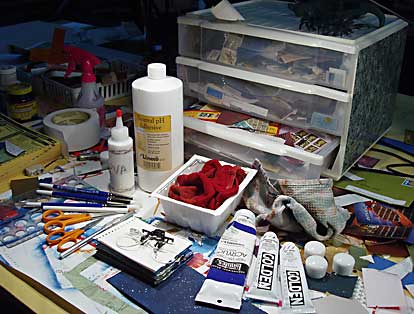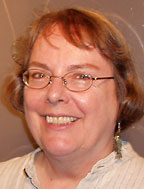Collage Demo: Part One
The Materials
I started doing collage when I lived near downtown San Jose and walked to San Jose State. There was a goldmine on the streets. I found bits of personal letters, photos, wrappers of all kinds and lots of other good stuff. It seemed to me that there were secret messages lying all over the sidewalk and I wanted to put these secrets into my art.
There are many different ways to do collage. Mine has evolved over the years in response to the materials I had and the effect I was trying to achieve. It works well for very small-scale images. Most of my artist’s books are under 5 inches in any direction. I love small-scale work. It’s intimate and works great in artist’s books, my favorite way to work in paper.

In the image above, you can see in the back my stash of small bits of paper in the drawers. In the middle: (left to right) phone book, small and large bottles of Lineco PVA, damp cloth in tofu tub, dry cloth. In the front: (left to right) some fabric brushes I’m testing, scissors, exacto knife, the stack of pages is the text block for my new book, with some clip-on magnifiers on top, acrylic paints and sewing weights. This image enlarges to show more detail.
I use polyvinyl acetate for glue. (Usually called PVA) This is similar to Elmer’s glue, but better quality. I buy Lineco brand, from a local store, Maggie's , or from Daniel Smith. It is a neutral ph adhesive that leaves my papers looking unchanged by the glue. It will dry up if left uncovered, so I pour some into a smaller container to work from.
There are many opinions about the best adhesive for collage and each product has its staunch fans. Each group claims its favorite glue is the only correct thing to use. I’m not a chemist, so I don’t know about any of this. To my knowledge PVA holds the best, acrylic gel mediums are next, and acrylic mediums have the least holding strength. I have used several different glues in one project with good results. Personally I would say it’s good to try them all and then go with what ever works for your style and personal preferences.
For collage materials I have boxes of old magazines, books that I can cut up, scraps of interesting papers, piles of maps and drawers of small bits of paper I have been collecting for years. I like to work on good quality watercolor paper. Usually I use Arches Hot Press, which is very smooth. I find that the rougher papers have too much texture for small-scale work. I use 90 lb papers for pages I want to fold and sew into books, and 300 lb for pages I treat as boards or for covers. Museum board is also a good book cover material. You can purchase good papers in art supply stores or online at Daniel Smith or Mister Art.
I like to use Golden acrylics to paint my book pages before I start the collage. I do have some Liquetex paints because they are easier to find locally.
I also keep worn out dish clothes in my studio. Because I get the glue on my hands, I like to work with a damp cloth and a dry cloth nearby. A tofu or yogurt tub is handy to keep the damp cloth in so your table doesn’t get wet.
Small scissors and a mat knife are important for cutting out delicate pieces of paper. You might also want some kind of magnifying glasses, colored pencils, and all your other usual art supplies. I also use sewing weights to hold down my pages as I work. If the paper is too buckled for the weights to hold, I might improvise something with tape instead. I use old phone books as pads of scrap paper. Whatever you use, if it has print, make sure it won’t run when wet.
There are other tutorials on my web site.
I started doing collage when I lived near downtown San Jose and walked to San Jose State. There was a goldmine on the streets. I found bits of personal letters, photos, wrappers of all kinds and lots of other good stuff. It seemed to me that there were secret messages lying all over the sidewalk and I wanted to put these secrets into my art.
There are many different ways to do collage. Mine has evolved over the years in response to the materials I had and the effect I was trying to achieve. It works well for very small-scale images. Most of my artist’s books are under 5 inches in any direction. I love small-scale work. It’s intimate and works great in artist’s books, my favorite way to work in paper.

In the image above, you can see in the back my stash of small bits of paper in the drawers. In the middle: (left to right) phone book, small and large bottles of Lineco PVA, damp cloth in tofu tub, dry cloth. In the front: (left to right) some fabric brushes I’m testing, scissors, exacto knife, the stack of pages is the text block for my new book, with some clip-on magnifiers on top, acrylic paints and sewing weights. This image enlarges to show more detail.
I use polyvinyl acetate for glue. (Usually called PVA) This is similar to Elmer’s glue, but better quality. I buy Lineco brand, from a local store, Maggie's , or from Daniel Smith. It is a neutral ph adhesive that leaves my papers looking unchanged by the glue. It will dry up if left uncovered, so I pour some into a smaller container to work from.
There are many opinions about the best adhesive for collage and each product has its staunch fans. Each group claims its favorite glue is the only correct thing to use. I’m not a chemist, so I don’t know about any of this. To my knowledge PVA holds the best, acrylic gel mediums are next, and acrylic mediums have the least holding strength. I have used several different glues in one project with good results. Personally I would say it’s good to try them all and then go with what ever works for your style and personal preferences.
For collage materials I have boxes of old magazines, books that I can cut up, scraps of interesting papers, piles of maps and drawers of small bits of paper I have been collecting for years. I like to work on good quality watercolor paper. Usually I use Arches Hot Press, which is very smooth. I find that the rougher papers have too much texture for small-scale work. I use 90 lb papers for pages I want to fold and sew into books, and 300 lb for pages I treat as boards or for covers. Museum board is also a good book cover material. You can purchase good papers in art supply stores or online at Daniel Smith or Mister Art.
I like to use Golden acrylics to paint my book pages before I start the collage. I do have some Liquetex paints because they are easier to find locally.
I also keep worn out dish clothes in my studio. Because I get the glue on my hands, I like to work with a damp cloth and a dry cloth nearby. A tofu or yogurt tub is handy to keep the damp cloth in so your table doesn’t get wet.
Small scissors and a mat knife are important for cutting out delicate pieces of paper. You might also want some kind of magnifying glasses, colored pencils, and all your other usual art supplies. I also use sewing weights to hold down my pages as I work. If the paper is too buckled for the weights to hold, I might improvise something with tape instead. I use old phone books as pads of scrap paper. Whatever you use, if it has print, make sure it won’t run when wet.
There are other tutorials on my web site.
Labels: Classes and Demos, Collage

0 Comments:
Post a Comment
Links to this post:
Create a Link
<< Home